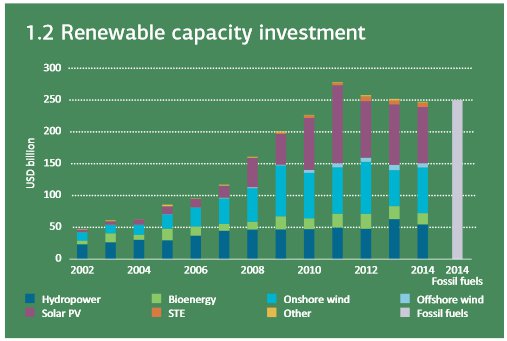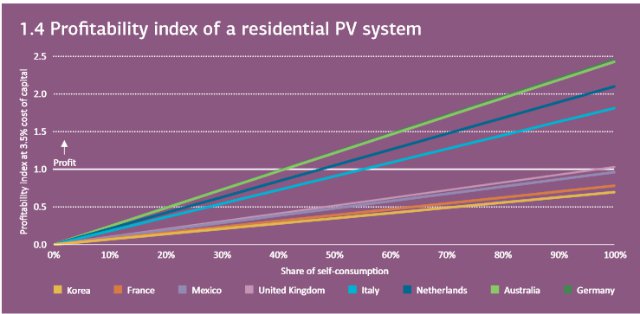Monday, 22/12/2025 | 13:02 GMT+7
According to the recent Tracking Clean Energy Progress 2015 report by IEA, we can see that the renewable power generation is continuing to progress, and it's expected to grow by 45% between 2013 and 2020, reaching 7310terawatt hours (TWh).

Renewable power generation is continuing to grow
However, due to slow economic growth and policy uncertainty in OECD member countries, we may see some struggles in this area. What do the recent trends tell us and what can we expect and predict in the upcoming years when it comes to renewable energy? Let's take a look.

(source: iea.org)
The largest renewable energy market
China remained the largest market, accounting for an estimated 23% of overall renewable electricity generation in 2014 and remained the largest onshore wind market globally, their installations have been around 20GW.
And in terms of the continent, in solar PV, Asia installed almost 50%of new solar PV capacity.
In the graph below, we can see that OECD Europe and OECD Americas are after China in renewable power generation, and we can expect a close to 30% target globally in the renewable energy space.

(source: iea.org)
Renwable capacity investment
Interesting, we are seeing a decrease in investment in solar PV, but a slight increase in offshore wind. And as expected, we are seeing a great amount still in the investment in fossil fuels.
Solar PV
In countries where generous feed-in-tariffs are in place, the solar PV market seems to be booming, such as in Japan. Although integration challenges are faced by developers due to some PV projects being implemented in locations where land is cheap but demand is low and grid capacity is limited. In some provinces, utilities have refused to connect projects where the grid is already highly congested. Grid integration was also a challenge in South Africa, where some solar PV and wind projects could not get a timely grid connection. This contributed to delays in the third and fourth rounds of renewable tenders.
And when it comes to residential PV systems, we see Australia, Netherlands and Italy are in the lead for profit generation.

(source: iea.org)
Wind energy
Both onshore and offshore wind energy are becoming to be more recongized with new turbine technology with larger rotor diameters being used in more low and medium wind sites.
However, due to high PPAs and high offshore wind costs, wind projects are being pushed for some countries; such as Germany lowering its 2020 offshore wind capacity target from 10GW to 6.5GW, while Denmark delayed auctioning a 600megawatt (MW) project.
The future
Although we are seeing an increased number in various kinds of renewable energy being deployed, policy actors and government regulations remain vital to contributing and shaping the future in this space.
Policy makers need to be able to invest seeing the long-term gains that provide a predictable and reliable market and regulatory framework compatible with societal goals.
Moreover, financial costs also play a huge role in aiding organizations, companies, investors build and deploy renewable energy projects so the banking and financial sector can also be involved to a greater extent in pushing the renewable energy envolope forward.
Lastly, countries beginning to deploy variable power plants should implement well-established best practices to avoid integration challenges. Markets with high variable renewable penetration should take advantage of their existing flexibility assets, and consider other flexibility mechanisms to optimise the balancing of their overall energy system.
(According to 2degreenetwork)








 Webinar 2: “Financial Support for Energy Efficiency Enterprises – Opportunities and Challenges”
Webinar 2: “Financial Support for Energy Efficiency Enterprises – Opportunities and Challenges”
 Vietnamese enterprises achieve green growth and cut costs through energy efficiency
Vietnamese enterprises achieve green growth and cut costs through energy efficiency
 Capacity Building for Program Implementing Entity
Capacity Building for Program Implementing Entity
 Enhance Energy Efficiency Knowledge for Managers of Cement Industrial Enterprises
Enhance Energy Efficiency Knowledge for Managers of Cement Industrial Enterprises
 Promoting Energy Efficiency for Technical Staff of Brick and Ceramic Sector
Promoting Energy Efficiency for Technical Staff of Brick and Ceramic Sector
 Capacity building for participating financial institutions of the VSUEE Project
Capacity building for participating financial institutions of the VSUEE Project
 Capacity building for participating financial institutions in Ho Chi Minh City
Capacity building for participating financial institutions in Ho Chi Minh City